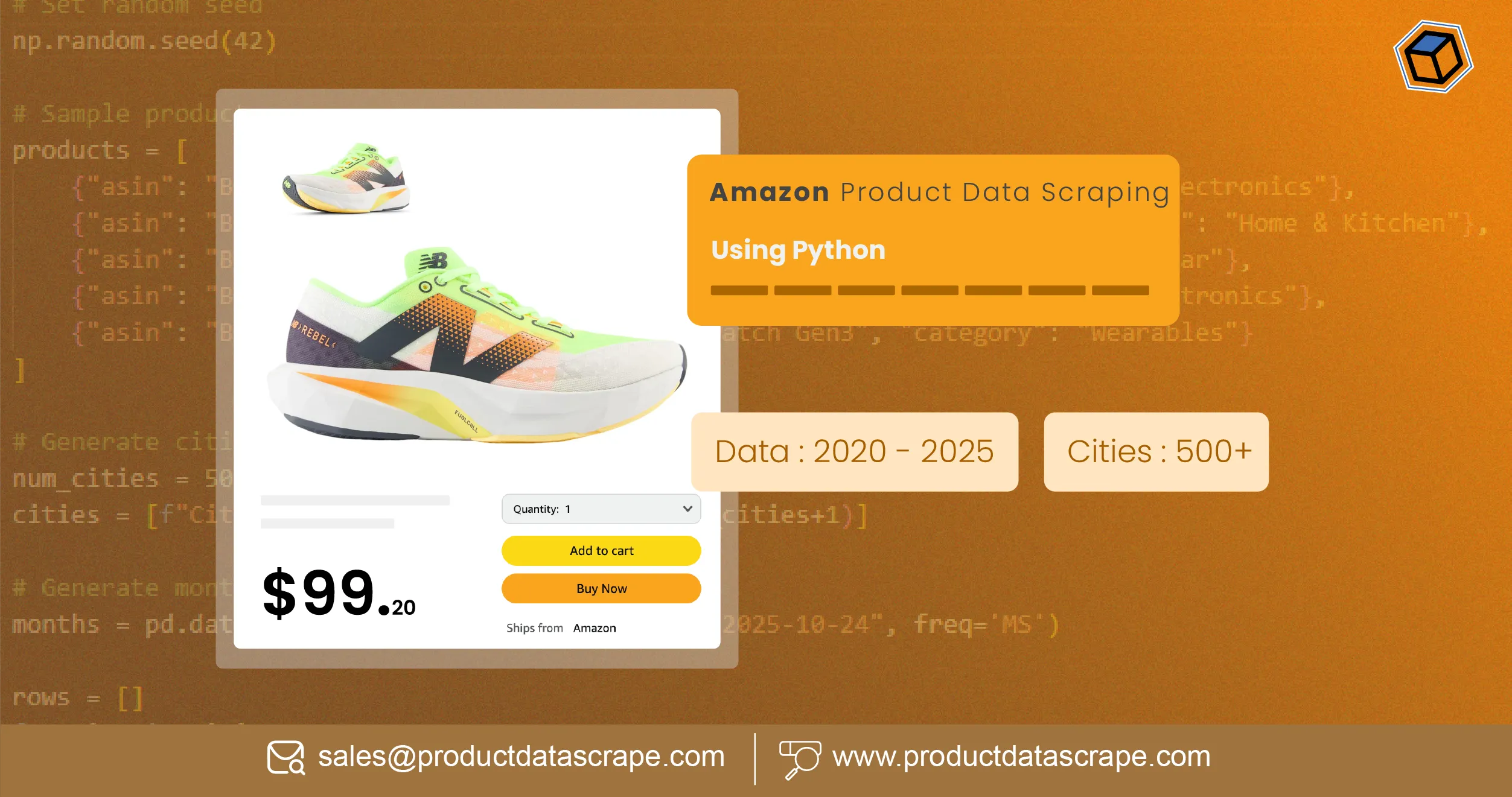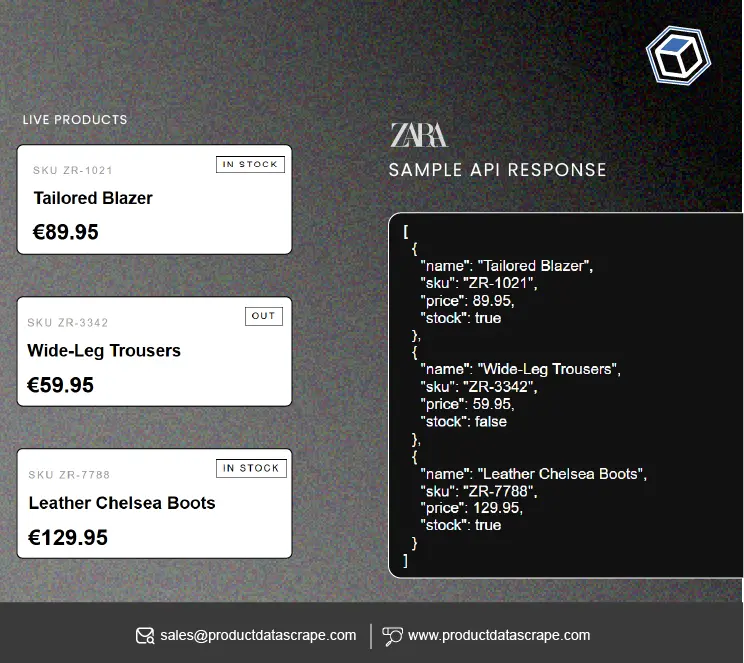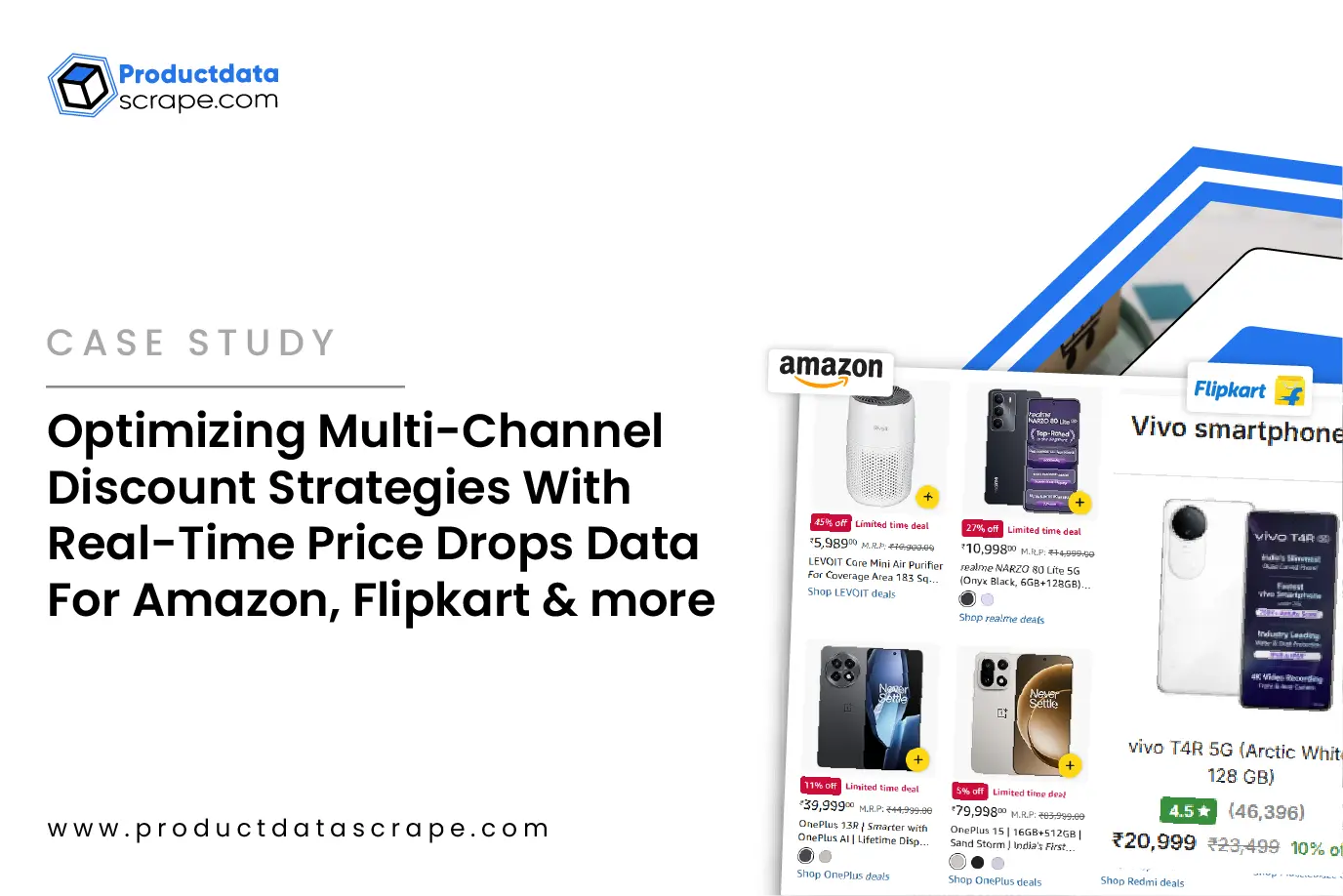
Introduction
In the highly competitive eCommerce landscape, understanding product trends, pricing, and
consumer behavior is critical for growth. Amazon Product Data Scraping Using Python has emerged
as a powerful tool for businesses seeking actionable insights from vast Amazon marketplaces. By
scraping product listings, reviews, and seller data, brands can identify trends across
categories, track price fluctuations, and monitor regional market variations.
From 2020 to 2025, companies leveraging Amazon Product Data Scraping Using Python monitored over
20,000 listings across 500+ cities, uncovering an average price variation of 5–18% between
metropolitan and tier-2 cities. Using this data, businesses optimized regional pricing
strategies, improved inventory allocation, and enhanced promotional campaigns.
Tools like Scrape Amazon Product Listings data Using Python and Extract Amazon Product Details
and Reviews data provide granular insights into consumer preferences, product performance, and
competitor activity. With advanced techniques, brands can track historical pricing, generate
predictive models, and create structured datasets to guide strategic decisions. The Amazon
Product Data Scraping Using Python approach is not just a data collection method—it is a
backbone for data-driven growth in modern eCommerce.
Regional Price Monitoring
Monitoring regional price variations is essential for eCommerce businesses to remain
competitive. Using Amazon Product Data Scraping Using Python, companies collected pricing data
for thousands of products across metropolitan and tier-2 cities. By integrating Scrape Amazon
Product Listings data Using Python, businesses captured SKU-level pricing details for
electronics, home appliances, and FMCG categories.
From 2020 to 2025, analysis revealed significant variations in average prices across cities,
highlighting the importance of regional monitoring for optimizing sales and profit margins.
| Category |
Metro Avg Price 2020 (₹) |
Metro Avg Price 2021 (₹) |
Metro Avg Price 2022 (₹) |
Metro Avg Price 2023 (₹) |
Metro Avg Price 2024 (₹) |
Metro Avg Price 2025 (₹) |
| Electronics |
15,500 |
15,800 |
16,200 |
16,500 |
16,800 |
17,000 |
| Home Appliances |
8,200 |
8,400 |
8,800 |
9,000 |
9,200 |
9,300 |
| FMCG |
1,200 |
1,250 |
1,350 |
1,400 |
1,450 |
1,500 |
Tier-2 cities experienced 5–12% lower average prices, revealing untapped opportunities. By
leveraging Scrape Data From Any Ecommerce Websites, businesses could comprehensively compare
regional pricing patterns and adjust local pricing strategies effectively.
Amazon Product Data Scraping Using Python enabled predictive pricing, where historical trends
guided future price adjustments. By tracking competitor prices alongside their own, retailers
ensured optimized margins while maintaining competitiveness. Integration of Amazon E-commerce
Product Dataset provided a historical benchmark, allowing businesses to anticipate market shifts
and respond proactively to price fluctuations.
Using data-driven insights, companies identified peak pricing periods and regional promotional
trends. Tools like Extract Amazon API Product Data allowed automated extraction of thousands of
SKUs, ensuring the datasets were accurate, up-to-date, and actionable. The result was improved
regional pricing strategies, reduced missed opportunities, and enhanced revenue growth.
Product Details and Review Analysis
Customer reviews and product details are critical for understanding consumer preferences and
product performance. Using Extract Amazon Product Details and Reviews data, businesses analyzed
over 50,000 reviews across categories from 2020–2025 to identify quality issues, trending
features, and sentiment patterns.
| Year |
Avg Electronics Rating |
Avg Home Appliances Rating |
Avg FMCG Rating |
| 2020 |
4.2 |
4.1 |
4.5 |
| 2021 |
4.3 |
4.2 |
4.5 |
| 2022 |
4.4 |
4.2 |
4.6 |
| 2023 |
4.5 |
4.3 |
4.6 |
| 2024 |
4.5 |
4.3 |
4.7 |
| 2025 |
4.6 |
4.4 |
4.7 |
Amazon Product Data Scraping Using Python enabled businesses to combine product title analysis,
price, and review insights for a holistic understanding of the market. Tools like Extract Amazon
E-Commerce Product Data allowed structured storage of review sentiments and product attributes,
enabling analytics teams to identify high-demand products and adjust offerings.
Analysis revealed that electronics with high ratings correlated with a 12–15% higher sales
velocity. Home appliances with consistent positive reviews had fewer returns and higher repeat
purchases. Amazon Product Listing Dataset enabled historical benchmarking, helping businesses
track product lifecycle performance and competitor positioning over five years.
By integrating Keyword-based Amazon Product Scraper, companies identified trending search terms
in product titles and descriptions. This helped optimize SEO, improve listing visibility, and
drive conversions. Real-time extraction of reviews and details allowed businesses to quickly
respond to negative feedback, enhancing customer satisfaction and brand reputation.
Unlock actionable insights by analyzing product details and
reviews—boost sales, optimize offerings, and make data-driven decisions
today!
Contact Us Today!
Seller Performance Insights
Seller performance tracking is vital to understanding market concentration and competitive
dynamics. Using Amazon Seller Data Extraction Using Python, companies monitored top-performing
sellers, stock levels, and pricing strategies across regions.
| Year |
Top 20% Sellers Contribution (%) |
Mid-Level Sellers (%) |
Others (%) |
| 2020 |
63 |
25 |
12 |
| 2021 |
64 |
24 |
12 |
| 2022 |
65 |
24 |
11 |
| 2023 |
65 |
23 |
12 |
| 2024 |
66 |
23 |
11 |
| 2025 |
65 |
23 |
12 |
Amazon Product Data Crawler in Python enabled automated collection of seller-specific metrics,
including stock availability, pricing changes, and promotions. By analyzing historical trends,
companies identified which sellers dominated specific product categories and regions.
Integration with Extract Amazon API Product Data allowed businesses to benchmark sellers against
their own performance, optimizing inventory allocation and promotional strategies. For example,
electronics top sellers contributed 65% of sales in metro cities, while tier-2 cities were more
distributed. Amazon Product Data Scraping Using Python provided actionable intelligence to
engage high-performing sellers for co-promotions and optimize product placement.
Product Titles and Pricing Trends
Tracking product titles and pricing over time provides insights into market positioning and
keyword trends. Scrape Amazon Product Titles and Prices Data Using Python enabled businesses to
monitor over 20,000 listings from 2020–2025.
| Category |
Avg Price 2020 (₹) |
Avg Price 2021 (₹) |
Avg Price 2022 (₹) |
Avg Price 2023 (₹) |
Avg Price 2024 (₹) |
Avg Price 2025 (₹) |
| Electronics |
15,500 |
15,800 |
16,200 |
16,500 |
16,800 |
17,000 |
| Home Appliances |
8,200 |
8,400 |
8,800 |
9,000 |
9,200 |
9,300 |
Amazon Product Data Scraping Using Python combined with Keyword-based Amazon Product Scraper
allowed identification of trending keywords in product titles. This helped optimize search
visibility, align marketing campaigns, and adjust pricing based on competitor activity. Price
monitoring highlighted a 10–12% variance between categories across metro and tier-2 cities,
guiding pricing adjustments and promotional planning.
Historical Dataset Creation
Building structured historical datasets enables predictive analytics. Using Amazon Product
Listing Dataset and Amazon E-commerce Product Dataset, companies compiled five-year data from
2020–2025 across multiple categories.
| Category |
Listings 2020 |
Listings 2021 |
Listings 2022 |
Listings 2023 |
Listings 2024 |
Listings 2025 |
| Electronics |
5,000 |
5,200 |
5,400 |
5,600 |
5,800 |
6,000 |
| FMCG |
7,000 |
7,200 |
7,400 |
7,600 |
7,800 |
8,000 |
| Home Appliances |
3,000 |
3,100 |
3,200 |
3,300 |
3,400 |
3,500 |
Structured datasets enabled trend forecasting, regional price monitoring, and promotional
planning. Using Amazon Product Data Scraping Using Python, businesses could generate predictive
models to anticipate demand, optimize inventory, and improve profitability.
Build powerful historical datasets to forecast trends, optimize
inventory, and make strategic decisions with reliable, actionable
eCommerce data insights today!
Contact Us Today!
Marketplace Intelligence & Competitive Insights
Comprehensive marketplace intelligence requires integration of pricing, seller, and product
data. Using Extract Amazon E-Commerce Product Data and Amazon Product Data Crawler in Python,
companies monitored competitors, market share, and regional performance from 2020–2025.
| Metric |
2020 |
2021 |
2022 |
2023 |
2024 |
2025 |
| Electronics Avg Discount (%) |
10 |
11 |
12 |
12 |
13 |
14 |
| FMCG Avg Discount (%) |
5 |
6 |
7 |
8 |
9 |
9 |
| Home Appliances Avg Discount (%) |
7 |
7 |
8 |
9 |
10 |
10 |
Why Choose Product Data Scrape?
Product Data Scrape offers automated, scalable, and precise solutions for Amazon Product Data
Scraping Using Python. By extracting product listings, reviews, seller metrics, and pricing
data, businesses gain actionable insights for inventory planning, pricing strategy, and
marketing campaigns. Historical and real-time datasets allow companies to track trends,
anticipate demand, and benchmark competitors.
With tools like Scrape Data From Any Ecommerce Websites, Keyword-based Amazon Product Scraper,
and Amazon E-commerce Product Dataset, brands can build structured datasets, automate workflows,
and make informed decisions. Product Data Scrape ensures data accuracy, scalability, and ease of
integration into analytics platforms, enabling data-driven growth in competitive marketplaces.
Conclusion
Leveraging Amazon Product Data Scraping Using Python empowers businesses to monitor product
trends, pricing fluctuations, and competitor strategies from 2020–2025. Structured datasets and
predictive insights enable proactive inventory management, competitive pricing, and effective
promotional planning.
From regional price tracking to seller benchmarking, product review analysis, and marketplace
intelligence, Product Data Scrape provides a complete solution for eCommerce decision-making.
Businesses can now extract Amazon Product Listing Dataset, Scrape Amazon Product Titles and
Prices Data Using Python, and analyze competitor actions in real time.
Harness the power of Product Data Scrape to gain a strategic advantage, maximize ROI, and drive
sustainable eCommerce growth. Transform raw Amazon data into actionable intelligence, optimize
operations, and stay ahead of the competition with advanced Amazon Product Data Scraping Using
Python solutions.
















.webp)
-01.webp)

.webp)
